CVN - Connected Vitality - The Personal Telepresence Network

(2010-2013) The goal of the project is to have a small scale Connected Vitality Network operational that is highly rewarded by elderly to fulfill meaningful social contacts and is intuitively suited for their needs and abilities.
- The technology enables elderly to gain autonomous telepresence at any time;
- Allows elderly to have their individual needs and interests as a starting point for all their video and audio communications;
- Allows elderly to interact with family, friends and other elderly in a natural and seamless way, unhindered by technological barriers;
- Group videocommunication formats like games, reading to grandchildren, group discussions etc. enabled by the Connected Vitality Network will act as a catalyst to create virtual communities, stimulating elderly restricted to poor social environments into social meaningful activities;
- Creating a generic open communication model with strong building blocks inviting third parties to create their own add-on modules, developing the network into a main infrastructure for all kind of social and care needs;
- Once implemented we believe this groundbreaking videotechnology will empower senior citizens far beyond current possibilities and help them to overcome social restraints, impaired mobility and isolation, so many suffer from today.
Challenge
Due to demographic changes across the continent the group of senior citizens in Europe will grow steadily. Unfortunately high age goes often together with limited mobility and physical impairments, resulting in an unwanted socially deprived environment for many elderly. The central goal of this project is to ensure that elderly are enabled to choose lifestyle and activities as well as levels of social interaction according to their individual needs and abilities. Changing ways of living and increasing demand for personal mobility that characterize modern society lead to new family structures in which relatives or close friends live or work at distant places. As a result, the risk of elderly persons to suffer from loneliness is high today and will further increase in the near future. This especially is the case with single seniors, living independently. Audio and video communication with family, friends and relatives which may live at distant places will become very important in this context, provided that respective communication devices will support the elderly in their social, care and practical, daily needs, while respecting their autonomy and privacy. The affordable Connected Vitality Network service fully empowers elderly by allowing them to broadcast themselves actively across the internet, rather then passively being broadcasted to. By doing so, it will strongly contribute to the well being and quality of life of the elderly by lifting them out of potential isolation, curb feelings of depression and sustain them to live independently. From a socio-economic perspective implementation of the network and services could lead to an innovation and integration of both health and home care services to the elderly; creating new public private partnerships, jobs and opportunities as well as a steep reduction of health and social care expenditures, as happy people simply require less care then unhappy people do.
Target group
Within the group of elderly citizens the CVN proposal explicitly aims at single elderly, living independently, willing to socially engage themselves and hindered by limited mobility, due to either age or physical impairments. As the percentage of elderly living in institutions, like elderly homes, range from 4% in Italy, to 9% in Sweden and The Netherlands, the great majority of elderly still live independently, either alone, widowed or with their spouse. The 2008-based national population projections EUROPOP2008 convergence scenario, compiled by Eurostat, show the population of the EU27 rising gradually from 495 million in 2008, reaching 521 million in 2035. The share of people aged 65 years or over in the total population is projected to increase from 17% to 30%. The number of people aged 75 years or over is even projected to almost triple from 22 million in 2008 to 61 million in 2060. The old age dependency ratio is expected to increase substantially from its current levels of 25% to 53% in 2060. Whereas in 2008 in the EU27 there are 4 persons of working age (15-64 years old) for every person aged 65 years or over; in 2060 the ratio is expected to be 2 to 1. Eurostat statistics further show that the decency rate strongly increases by age. For Europe this ongoing demographic development has significant socio-economic implications: in the future, there will be more older people in absolute as well as relative terms, there will be considerably more old people particularly in the upper age range, there will be fewer family careers providing informal support to these, and there will be a smaller productive workforce to contribute to the creation of economic wealth and to the financing of health and social services in particular. This ageing in the population, linked to the dependence situation, carries on social, health and economic problems and requires a progressive transformation to promote autonomy in elderly. This transformation could involve the physical and social environment, the innovation of service concepts to sustain the lifestyle, health and well being of the elderly, and the role of information technology, including telepresence.
Technology
The Connected Vitality Network consists of an encrypted network consisting of a WAN server and an unlimited number of clients, where senior citizens can log on to and connect with others CVN-listed members. Thanks to the new H.246 SVC video standard to de deployed in the CVN, for the first time up to 50 people can simultaneously participate in one group videoconference. At the home end of the subscriber a telepresence system is installed on which monitor, once switched on, other online CVN members are displayed in thumbnails. Through voice activation the speaker’s image is centrally displayed until someone else takes over the conversation.
At the receiving end either another telepresence system or a PC fitted with a high resolution webcam is available to allow high definition video communication. Compared with current videoconference systems this multipoint Connected Vitality Network offers the following advantages: up to 50 participants in one group video conference; high definition video quality over standard internet connections; a stable, encrypted network complying with all privacy requirements; customized applications development, i.e. Connected Vitality Network desktop and user interface; camera control software; one single button to activate/ deactivate the telepresence system (kiosk mode); remote access for software updates and problem solving; reducing IT support costs; automated firewall negotiations, allowing the telepresence system even to operate in complex network environments. The result is HD/Telepresence quality enhanced by high resilience and low-latency, delivered over general-purpose Internet Protocol (IP) networks.
Functions and content
From a content point of view, the Connected Vitality Network wil offer subscribers four main communication functions:
- CONTACT – single point videoconferencing; linking elderly with family, friends and relatives, fulfilling social needs;
- CARE – singe point videoconferencing; linking elderly with caregivers and home service providers, like food and home maintenance fulfilling practical, daily needs;
- COMMUNITY – multipoint group videoconferencing; based on shared interests, hobbies, pastimes and personal experiences;
- KNOWLEDGE TRANSFER – multipoint group videoconferencing based on livelong learning and knowledge transfer between peers and generations.
The first basic function is CONTACT, connecting elderly at any convenient time with other people. Apart from a core group of family and friends to socially chat with, we further consider to include specific CARE suppliers and service providers, critical to elderly, like home food services, repair men, bankers and insurers, pharmacists, paramedics and (home) caregivers. Professionals upon whom they often depend for their comfort and wellbeing and who enable them to live independently. The formatted timeslots within the CVN subscription are geared to small COMMUNITIES of elderly, sharing mutual interests, hobbies, experiences or just virtually a drink or meal. KNOWLEDGE TRANSFER enables elderly to transfer their livelong experience and knowledge amongst themselves and to younger generations, i.e. helping young mothers preparing to give birth; supporting kids with their school homework; coaching children in their social skills etc. To that end, upon subscribing to the service, the senior citizen is interviewed upon their personal life and lifestyle, interests, hobbies, past professional and personal experiences etc. These personal profiles are indexed and tagged, much as Google indexes webpages, and staged onto the subscriber database on the CVN server. By doing so we are able to bring people together whom, for instance, were born in the same region; went to the same school; played at the same sportsclub; worked at the same office or factory or went to the same church etc. Shared (previous) hobbies, like reading, sports, gardening, (card) games, chess and checkers, embroidery etc. are another means of connecting people, as shared memories of historic events and current needs, like medical advise, group workout or religious services might do as well. By using database techniques, the Connected Vitality Network allows elderly, in other words, to connect with others whom they share common interests and backgrounds with. The second step is to bring small groups consisting of 6 to 10 people virtually together via the network on specific programmed timeslots to talk and discuss these interests among each other. Pilots have to demonstrate whether these groups require further moderation or are perfectly capable to conduct a conversation, interesting to all participants.
http://www.connectedvitality.eu
Articles:
Világgazdaság, Telebit, 28-10-2011, Távdiagnózis a virtuális térből – the article (in Hungarian)
Világgazdaság, Telebit, 29-04-2013, Magány helyett virtuális együttlét – the article (in Hungarian)
Presentations about the project:
Rehabilitation Center for Disabled People (MEREK), 01-03-2012, Lóránt Vajda: Telepresence against loneliness – the presentation (in Hungarian)
- Summary of the event in MEREK (in Hungarian)
- Prim Online (in Hungarian)
- Infovilág (in Hungarian)
- Medical Online (in Hungarian)
BME EMT Open Day, 29-11-2012, Lóránt Vajda: Telepresence against loneliness – the presentation (in Hungarian)
BME EMT Open Day, 13-12-2012, Lóránt Vajda: Telepresence against loneliness – the presentation (in Hungarian)
Exhibitions:
CVN at INNOTRENDS HUNGARY 2013, June, 2013 – summary, photos


